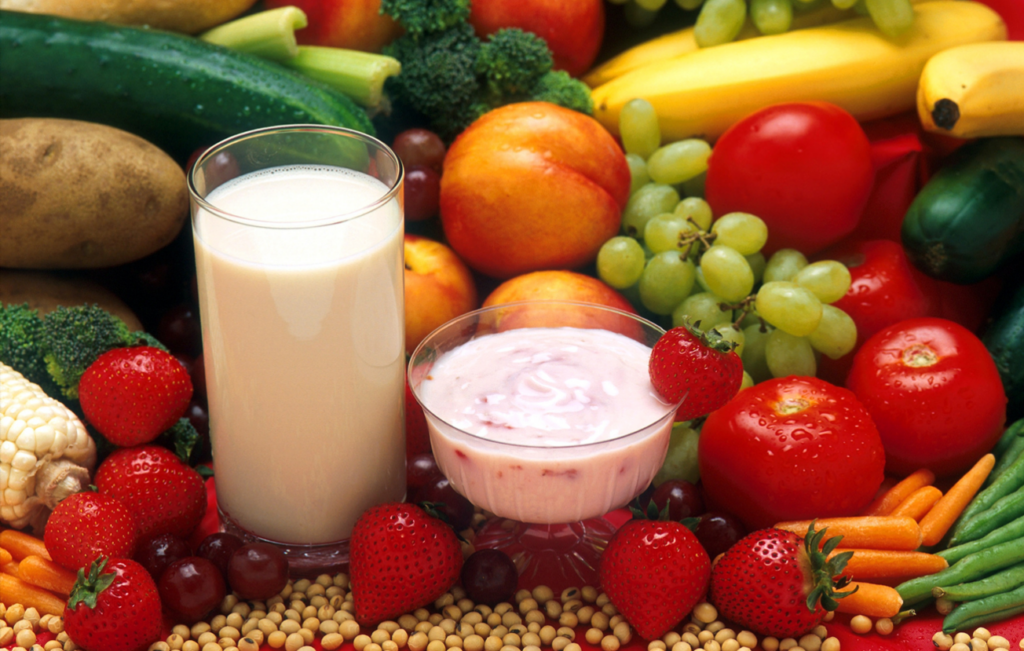by L. Bellows and R. Moore* (3/13)
Updated by J. Clifford and T. Lane** (11/21)
Quick Facts…
- Most Americans do not meet the daily recommended intake for potassium.
- Potassium is found in unprocessed meats, and milk, as well as fruits and vegetables such as leafy greens, fruit from vines, and citrus.
- A diet low in potassium and high in sodium may be one of many factors leading to high blood pressure (hypertension), and cardiovascular disease.
- Following a diet that includes more potassium-rich fruits and vegetables, and less sodium containing processed foods is recommended.
- Athletes involved in exercise greater than one hour in duration may require larger quantities of potassium rich foods.
- Potassium supplements are not recommended unless consumption is monitored by a medical professional.
What is Potassium?
Potassium is an essential mineral and a major electrolyte found in the human body. It plays an important role in electrolyte regulation, nerve function, muscle control, and blood pressure. Potassium is found within all cells of the body, and its levels are controlled by the kidneys. Primarily, potassium functions to regulate water and mineral balance throughout the body.
Potassium works with sodium to maintain the body’s normal blood pressure. Research suggests that increasing dietary potassium may provide a protective effect against hypertension by increasing the amount of sodium excreted from the body. An adequate potassium intake has also been linked to a reduced risk of death due to cardiovascular disease. It is recommended that individuals focus on food sources to increase potassium intake and avoid supplements unless indicated by a medical professional.
Sources of Potassium
Potassium is found in many foods, especially those of plant origin such as oranges, potatoes, avocados, bananas, and tomatoes. Potassium can also be found in fish, meat, and dairy products. Highly refined food items such as oils, sugar, and fats lack potassium.
Overall, most Americans do not get enough potassium in their diet. In recent decades, the American diet has shifted towards consumption of processed foods, such as fast food, canned, or prepackaged food items. The majority of these foods contain little potassium, and are high in sodium. In order to ensure a diet rich in potassium, it is important to eat a variety of fresh fruits and vegetables. Eating more fresh and frozen foods, which are usually lower in sodium, may be helpful. For more information on how to reduce sodium intake, see fact sheet Sodium and the Diet.
How Much Potassium is Required?
The Adequate Intakes (AI) for potassium have changed since the National Academies of Science, Engineering and Medicine (NASEM) committee updated the Daily Reference Intakes (DRIs) in 2019. See Table 1 for the new potassium AIs.
| Table 1: Adequate Intakes (AI) for Potassium by Age and Sex | ||
| Age | AI for Females (Milligrams) | AI for Males (Milligrams) |
| 0-6 months | 400 | 400 |
| 7-12 months | 860 | 860 |
| 1-3 years | 2,000 | 2,000 |
| 4-8 years | 2,300 | 2,300 |
| 9-13 years | 2,300 | 2,500 |
| 14-18 years | 2,300 Pregnancy: 2,600 Lactation: 2,500 | 3,000 |
| 19-50 years | 2,600 Pregnancy: 2,900 Lactation: 2,800 | 3,400 |
| 51+ years | 2,600 | 3,400 |
Special Recommendations:
For those with high blood pressure or hypertension—Following an eating plan known as the DASH Diet (Dietary Approaches to Stop Hypertension) may be useful for lowering blood pressure. The DASH diet is higher in potassium, magnesium, and calcium, while lower in total fat, saturated fat, and sodium than the typical American diet. For more information about the DASH eating plan or diet and hypertension, see fact sheet Diet and Hypertension or fact sheet Understanding the DASH Diet. Potassium supplements are generally not recommended for people with hypertension. Instead, a variety of potassium rich foods should be eaten daily.
For athletes and those strenuously active for more than 1 hour in duration—Prolonged exercise, as well exposure to temperatures and conditions that result in excessive fluid loss may require increased potassium intake. Low potassium can cause muscle cramping and cardiovascular irregularities. Consuming foods high in potassium can prevent these symptoms. One cup of orange juice, a banana, or a potato is sufficient to replace the potassium lost during one to two hours of hard exercise.
For those with renal disorders—Potassium intake is inversely related to the risk for kidney stone formation, and those prone to kidney stones usually have diets high in sodium and low in potassium. Those with kidney injury or renal failure should monitor potassium levels carefully, as a high concentration of potassium in the tissue can result in the inability to filter potassium efficiently.
Potassium Deficiency
Potassium deficiency is not common but may occur from excessive fluid loss due to severe diarrhea, strenuous exercise, or use of diuretics. Deficiency may also result from poor control of diabetes, low-calorie diets (less than 800 calories per day), chronic alcoholism, or kidney problems. Deficiency symptoms include muscle cramps, loss of appetite, nausea, fatigue, and weakness.
Too Much Potassium?
There is no Tolerable Upper Intake Level (UL) for potassium because toxicity is rare in healthy individuals. Excess amounts of potassium are normally excreted from the body; however, problems may arise in those with kidney problems. If excess potassium cannot be excreted, conditions such as heart problems and sudden death may occur. Potassium toxicity is usually only a problem if one consumes potassium supplements in excess, which may result in muscle weakness, stomach pain, or irregular heartbeat.
Steps to Increase Dietary Potassium
- Include fruits and vegetables that are high in potassium—especially avocado, banana, cantaloupe, oranges, dried plums (prunes), artichokes, potatoes, spinach, and squash. High potassium fruits and vegetables usually contain about 200-400 milligrams of potassium per half cup serving.
- Prepare sweet potatoes or regular potatoes with the skin on, which is where much of the nutrients are! Potatoes contain even more potassium per serving than bananas.
- Consume non-fat dairy products such as milk, yogurt, or cottage cheese, which contain 300-400 milligrams of potassium per one cup serving.
- Enjoy potassium rich legumes such as soybeans, lima beans, and white beans, which contain 300-600 milligrams of potassium per half cup serving.
- Include lean meats such as salmon and other fish, chicken, and turkey—each provide over 400 milligrams of potassium for every 3-ounce portion.
- While it is important to consume foods rich in potassium, be aware of hidden sources of sodium in canned vegetables and legumes. Be sure to drain and rinse canned food before it is consumed to reduce sodium content.
- Choose fruits and vegetables for a snack, or salt free nuts such as almonds. Just a two ounce serving of nuts can provide over 350 milligrams of potassium.
| Table 2. Where is the Potassium? High, moderate, and low levels of potassium found in various food groups. | ||
|---|---|---|
| High Level (300 milligrams or greater per serving size) | ||
| SOURCE | Serving Size | Milligrams (mg) |
| Dairy | ||
| Nonfat Milk | 1 cup | 382 |
| Yogurt | 1 cup | 579 |
| Fruit | ||
| Apricots | 3 | 378 |
| Bananas | 1 Medium | 422 |
| Cantaloupe | 1 cup | 368 |
| Orange juice | 3/4 cup | 355 |
| Meat | ||
| Chicken | 3 ounces | 383 |
| Fish | 3 ounces | 375 |
| Canned salmon, tuna* | 3 ounces | 484 |
| Vegetables | ||
| Carrot juice | 3/4 cup | 517 |
| Celery | 1 stalk | 312 |
| Dry beans, cooked | 1/2 cup | 355 |
| Greens, cooked | 1/2 cup | 655 |
| Potato, baked | 1 medium | 610 |
| Spinach | 1/2 cup | 419 |
| Squash, winter | 1/2 cup | 448 |
| Sweet potato | 1 large | 694 |
| Tomato | 1 large | 300 |
| Tomato juice | 3/4 cup | 417 |
| Other | ||
| Molasses | 1 tablespoon | 498 |
| Nuts, unsalted | 1/2 cup | 340 |
| Moderate Level (100-300 milligrams per serving size) | ||
| Apples | 1 large | 148 |
| Grapefruit juice | 1/2 cup | 180 |
| Nectarines | 1 medium | 273 |
| Orange | 1 medium | 237 |
| Peaches | 1 medium | 186 |
| Strawberries | 1 cup | 254 |
| Raisins | 1/4 cup | 273 |
| Meat | ||
| Beef | 3 ounces | 290 |
| Ham | 3 ounces | 182 |
| Lamb | 3 ounces | 259 |
| Pork | 3 ounces | 105 |
| Vegetables | ||
| Broccoli | 1/2 cup | 278 |
| Beets | 1/2 cup | 267 |
| Peas | 1/2 cup | 175 |
| Other | ||
| Peanut butter | 2 tablespoons | 208 |
| Low Level (Less than 100 milligrams per serving size) | ||
| Breads and Cereals | ||
| Bread | 1 slice | 69 |
| Pasta | 3/4 cup | 81 |
| Dairy | ||
| American cheese | 1 ounce | 58 |
| Eggs | 1 | 55 |
| Fruit | ||
| Applesauce | 1/2 cup | 90 |
| Blueberries | 1/2 cup | 50 |
| Grapes | 10 medium | 72 |
| Meat | ||
| Bacon* | 3 slices | 45 |
| Bologna | 1 slice | 48 |
| Corned beef* | 3 ounces | 61 |
| Vegetables | ||
| Corn | 1/4 cup | 100 |
| Black olives* | 10 | 0 |
| Other | ||
| Butter | 1 tablespoon | 3 |
*These foods have high sodium content (greater than 300 milligrams per serving).
References
Berdanier, C.D., & Berdanier, L.A. (2021). Advanced Nutrition: Macronutrients, Micronutrients, and Metabolism. CRC Press, Taylor & Francis Group.
Duyff, L.D. (2012). American Dietetic Association: Complete Food and Nutrition Guide. Hoboken: John Wiley & Sons, Inc.
Gropper, S.S., Smith, J.L., Carr, T.P. (2018). Advanced Nutrition and Human Metabolism. Wadsworth, Cengage Learning.
Hoppe, L. K., Muhlack, D. C., Koenig, W., Carr, P. R., Brenner, H., & Schöttker, B. (2018). Association of Abnormal Serum Potassium Levels with Arrhythmias and Cardiovascular Mortality: a Systematic Review and Meta-Analysis of Observational Studies. Cardiovascular drugs and therapy, 32(2), 197–212. https://doi.org/10.1007/s10557-018-6783-0
Krogager, M. L., Søgaard, P., Torp-Pedersen, C., Bøggild, H., Lee, C. J., Bonde, A., Thomassen, J. Q., Gislason, G., Pareek, M., & Kragholm, K. (2020). Impact of plasma potassium normalization on short-term mortality in patients with hypertension and hypokalemia or low normal potassium. BMC cardiovascular disorders, 20(1), 386.
https://doi.org/10.1186/s12872-020-01654-3
Mahan, L. K., Morrow, K., Raymond, J. L., & Krause, M. V. (2020). Krause’s food & the nutrition care process. St. Louis, Mo: Elsevier/Saunders.
National Institutes of Health (NIH) (2021, March 26). Potassium: Fact Sheet for Professsionals. NIH Website. https://ods.od.nih.gov/factsheets/Potassium-HealthProfessional/.
O’Donnell, M., Mente, A., Rangarajan, S., McQueen, M. J., Wang, X., Liu, L., Yan, H., Lee, S. F., Mony, P., Devanath, A., Rosengren, A., Lopez-Jaramillo, P., Diaz, R., Avezum, A., Lanas, F., Yusoff, K., Iqbal, R., Ilow, R., Mohammadifard, N., Gulec, S., … PURE Investigators (2014). Urinary sodium and potassium excretion, mortality, and cardiovascular events. The New England journal of medicine, 371(7), 612–623. https://doi.org/10.1056/NEJMoa1311889
Stipanuk, M.H., & Caudill, M.A. (2019). Biochemical, Physiological, Molecular Aspects of Human Nutrition. Saunders, Elsevier Inc.
U.S. Department of Agriculture and U.S. Department of Health and Human Services. Dietary Guidelines for Americans, 2020-2025. 9th Edition. December 2020. Available at DietaryGuidelines.gov.
Colorado State University, U.S. Department of Agriculture and Colorado counties cooperating. CSU Extension programs are available to all without discrimination. No endorsement of products mentioned is intended nor is criticism implied of products not mentioned.
Go to top of this page.








